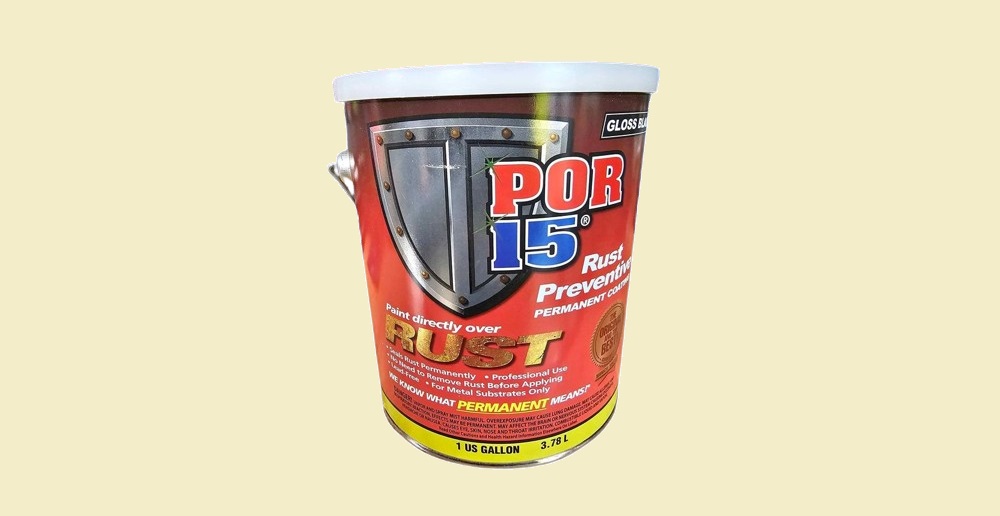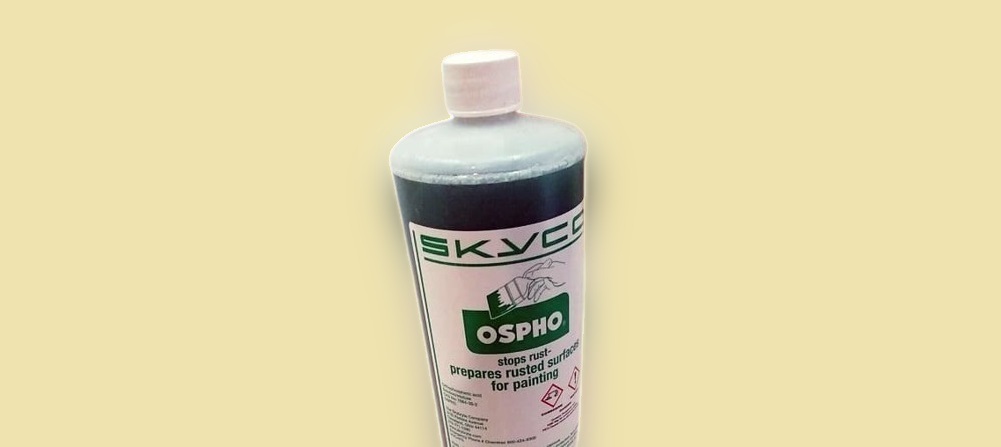Rust can be a relentless enemy, particularly regarding the longevity and aesthetics of metal structures and vehicles.
Whether you’re a car restoration hobbyist or dealing with household rust issues, selecting the right rust-prevention product is crucial.
Two standout options in the rust treatment market are POR-15 and Ospho, each bringing unique benefits and specific application processes.
This comparison will help you understand their characteristics and determine which product best suits your needs.

Table of Contents
What is POR-15?
POR-15 stands for “Paint Over Rust” and is renowned for its strength in permanently sealing rust.
Unlike traditional rust converters, POR-15 is a moisture-cured coating designed to stop rust from spreading by creating a hard, non-porous surface over rusted metal.
It is particularly famous for its effectiveness in harsh weather and corrosive elements.

What is Ospho?
Conversely, Ospho is a rust inhibitor known for its straightforward application and effectiveness in converting rust into a stable compound.
It primarily uses phosphoric acid to react with rust and transform it into iron phosphate, a black or dark gray layer that provides a paintable surface. This makes it an excellent primer for further protective treatments.
1. Chemical Properties
The effectiveness of any rust treatment solution largely depends on its chemical composition and how it interacts with rusted surfaces.
POR-15 and Ospho are formulated with unique ingredients that define their application and performance.
POR-15
Key Ingredients and Rust Prevention Technology
POR-15’s formula is centered around a moisture-curing urethane, which uses ambient moisture to harden.
This unique technology helps it form a robust and durable barrier impermeable to water and resistant to chemicals, alkalis, and acids. This barrier stops rust in its tracks and prevents it from spreading.
Paint-like, Sealing Properties
Unlike typical coatings, POR-15 acts like a thick, protective paint. It doesn’t just cover rust; it seals it with a layer that air and moisture cannot penetrate.
This sealing property is critical for its effectiveness, especially when metal is frequently exposed to moisture and other corrosive elements.
Ospho
Key Ingredients, Primarily Phosphoric Acid
The active ingredient in Ospho is phosphoric acid, which reacts chemically with the iron oxide (rust) to form iron phosphate.
This reaction is fundamental to how Ospho stabilizes rusted metal surfaces, making them less reactive and ready for a new coat of paint or sealant.
Reaction Mechanism with Rust to Form Iron Phosphate
When applied to a rusted surface, Ospho’s phosphoric acid interacts directly with the rust, transforming it into a black or dark gray iron phosphate layer.
This layer is more stable and less reactive than rust, providing an excellent primer surface for further painting and sealing.
2. Application Process
How rust treatment products are applied can significantly affect their efficiency and longevity. POR-15 and Ospho come with specific preparation and application instructions to ensure optimal performance.
POR-15
Necessary Surface Preparation (Cleaning and Degreasing)
Before applying POR-15, the surface needs thorough preparation. Cleaning and degreasing are critical because contaminants on the surface can prevent the coating from adhering properly.
It’s important to remove all grease, oil, and dirt; sometimes, you might even need to remove loose rust to ensure a solid bond.
Application Method (Brush, Roller, or Spray)
POR-15 can be applied using a brush, roller, or spray, depending on the size and complexity of the job. Spraying can provide a more uniform coat but requires specialized equipment.
Brushing or rolling is more accessible and can be just as effective, especially for small projects or in detailed areas.
Required Environmental Conditions for Optimal Curing
The moisture-curing nature of POR-15 means humidity plays an essential role in the curing process. Ideal conditions include moderate to high humidity, which helps the coating cure to a hard, durable finish.
However, direct exposure to water or rain before curing can damage the finish, so timing your application with the weather is essential.
Ospho
Surface Preparation Needs (Minimal Cleaning)
Ospho requires less intense preparation compared to POR-15. While the surface must be free of dirt and grease, perfect cleaning isn’t as critical because Ospho is designed to interact with rust.
It’s more forgiving regarding surface conditions, making it quicker and easier to use, especially for large areas.
Application Method (Brush or Spray) and Reaction Time
Applying Ospho can be done with a brush or spray. Spraying is often preferred for even coverage, especially over large, uneven surfaces.
Once applied, Ospho needs time to react with the rust. It usually takes a few hours to show the full chemical conversion of rust into iron phosphate.
No Curing Time Required; Reacts and Dries with Air Contact
Unlike POR-15, Ospho does not require a curing time. It dries upon exposure to air, with the reaction time depending primarily on temperature and humidity.
This makes it a quick solution for treating rust, especially when time is a constraint or when multiple treatment layers are planned.
3. Effectiveness and Performance
The effectiveness and longevity of the treatment are essential when dealing with rust. POR-15 and Ospho have proven track records, but their performance characteristics serve different needs and situations.
POR-15
Durability and Resistance to Further Rusting
POR-15 is highly celebrated for its durability and ability to solve rust issues permanently. Once cured, the coating is extremely tough, resistant to impacts, and impervious to moisture and other corrosive elements.
This makes it an excellent choice for areas exposed to harsh conditions, where ongoing rust protection is critical.
Best Performance on Already Rusted Surfaces
Interestingly, POR-15 performs best when applied directly to rusted metal. It uses rust as part of the bonding process, enhancing its adhesion and effectiveness.
This feature makes it particularly useful for older vehicles, metal structures, and equipment that have already begun to rust, as stopping the rusting process offers them a new lease on life.
Ospho
Effectiveness in Converting Rust into a Paintable Surface
Ospho’s main advantage is its ability to convert rust into a stable, paintable surface quickly and efficiently. By transforming rust into iron phosphate, Ospho creates a roughened surface texture that is ideal for painting.
This conversion is crucial for preventing further oxidation and ensuring that subsequent paint layers adhere better and last longer.
Best Used as a Pre-treatment Before Painting
While Ospho does not provide a protective coating as robust as POR-15, it is an excellent pre-treatment step before painting.
It prepares rusted surfaces for a new coat of paint, ensuring that the paint adheres properly and the rust does not continue to spread underneath.
This makes it ideal for less severe rust situations or where a painted finish is desired for aesthetic reasons.
4. Recommended Uses
Selecting between POR-15 and Ospho depends on their chemical properties, application methods, and the specific use cases for which they are best suited.
Each product excels in different scenarios, making understanding their recommended uses crucial for achieving optimal results.
POR-15
Ideal for Severe Rust Issues on Vehicle Frames, Undercarriages
POR-15 is particularly effective for treating severe rust issues requiring durability and resistance to harsh conditions. It is often the go-to for automotive restoration projects, especially vehicle frames and undercarriages.
These areas are prone to significant exposure to moisture, road salts, and physical abrasion, making the robust protection offered by POR-15 ideal.
Not Recommended Over Non-rusted or Smooth Metal Surfaces
Remember that POR-15 is specifically formulated to bond with rusted metal surfaces.
Its application on non-rusted or smooth metals is not recommended as it may not adhere properly, which could lead to peeling or flaking over time. Other forms of protection might be more suitable for new or non-rusted metal.
Ospho
Suitable for Rusted Metal Surfaces in Preparation for Painting
Ospho is excellent for preparing rusted metal surfaces that will be painted. It is ideal for a wide range of metals, including iron, steel, and even galvanized and aluminum surfaces when mild rusting has occurred.
By converting rust into a stable iron phosphate layer, Ospho ensures that the paint applied over it adheres better and lasts longer.
Use On Various Metals, Including Galvanized and Aluminum
Ospho’s versatility extends to various metals, not just iron and steel. This makes it a handy solution for diverse projects, from automotive parts to outdoor metal structures and household items that have begun showing signs of rust.
Its ability to prepare these surfaces for painting makes it a valuable tool in preventive maintenance and restoration tasks.
5. Cost and Value
Evaluating the cost and overall value of rust treatment products like POR-15 and Ospho is crucial, especially when considering their effectiveness and the specific uses they are recommended for.
Understanding the financial aspects can help you make a cost-effective decision based on the scale and nature of your project.
POR-15
Cost per Unit and Estimated Coverage Area
POR-15 typically costs more than conventional rust treatment solutions. However, the required coverage area and the application thickness must be considered.
Due to its dense, paint-like consistency, a small can of POR-15 can cover a surprisingly large area. This makes it a more economical choice for large projects, where its long-lasting protection can offset the initial higher cost.
Value Analysis Based on Durability and Resistance to Elements
The value of investing in POR-15 lies in its unmatched durability and robust protection against further rusting. For projects where longevity and resistance to harsh environmental conditions are paramount, POR-15 provides substantial value.
This is especially true for automotive applications, industrial settings, or marine environments where the cost of frequent replacements or repairs due to rust damage can be prohibitive.
Ospho
Cost per Unit and Estimated Coverage Area
Ospho is generally more affordable per unit than POR-15 and is sold in larger quantities, which may be more suitable for extensive projects that require a broad application.
Its liquid nature and ease of application also reduce product waste during the application process, increasing cost-effectiveness.
Value Analysis Based on Efficiency as a Rust Converter and Primer
The main value of Ospho lies in its dual function as a rust converter and a primer for painting. This makes it highly cost-effective for preparatory treatments before painting, reducing the need for additional priming products.
For projects where the final appearance is crucial and painting is necessary, using Ospho can significantly enhance the quality and durability of the paint job while keeping costs lower.
Conclusion
When deciding between POR-15 and Ospho for rust treatment, the specific requirements of your project must be considered.
POR-15 is ideal for areas requiring durable, long-lasting protection against harsh conditions, making it perfect for severe rust issues on vehicle frames and undercarriages.
On the other hand, Ospho is excellent for preparing rusted surfaces for painting, providing a cost-effective solution for various metals, including galvanized and aluminum.
Understanding both options’ cost, coverage, and application processes will help you choose the most suitable product for ensuring lasting results and value in your rust treatment and prevention efforts.
